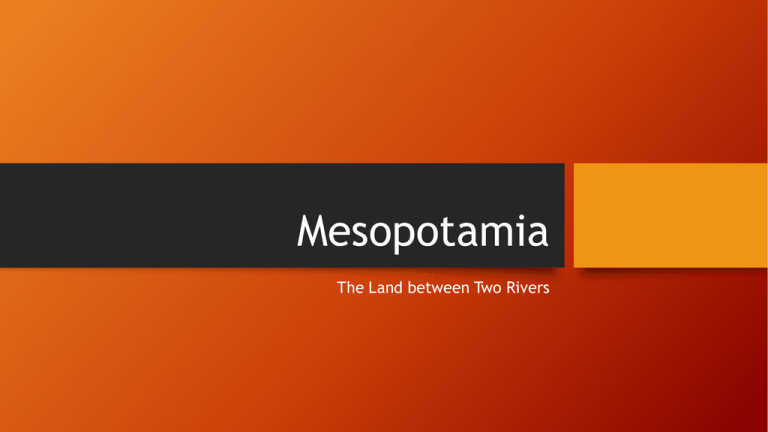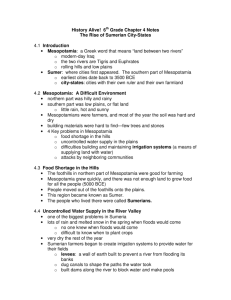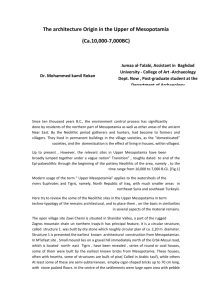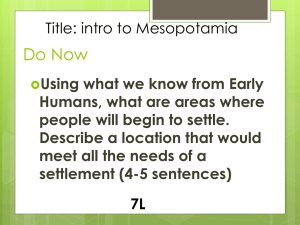Mesopotamia
advertisement

Mesopotamia The Land between Two Rivers Rise of “city-states” in Mesopotamia • Mesopotamia (Land of rolling hills and low plains) • Today is Iraq • Located between the Tigris & Euphrates River • Cities first appeared on the southern part of the land • Earliest cities in this area date back to 3500 BCE Similar to small independent countries -Had their own ruler -Own farmland Walled settlement surrounded by farmland (supplied food) Strong city walls made from sunbaked bricks Moats or ditches built around -Keep out enemies -During an attack people who lived outside the city walls would flee inside for protection Cities The Difficult Environments of Mesopotamia Northern(Foothills of the Zagros Mountains) • Overpopulated with limited resources • Hilly • Received lots of rain • Southern had low plains (flat land) • Sun beat down fiercely • Little rain (except during the flood season) • Most of the year the soil was hard and dry • Materials were difficult to find • Plenty of reeds (weed grows near the river) • Few trees (wood) • Stone was scarce • Few natural barriers 4 Problems Surviving the Environment 1) Food shortages in the hills 2) Uncontrolled water in plains 3) Difficulties building and maintain systems that provided water across village boundaries 4) Attacks by neighboring villages Food Shortages in the Hills(Neolithic Age) Zagros Mountains in the northern Mesopotamia (Rolling hills) • Mild weather and plenty of rain Wooded hills provided timber for building shelters Plenty of stone for tool making 5000 BCE farmers did not have enough land for growing population (food shortage) • South (below the foothills) Euphrates and Tigris ran through the flat plains • It lacked resources (stone and trees) • Spring rivers flooded and brought water and people began to believe that the land had promise • Due to the need for food people moved out of the foothills and into the plains region Sumer • Few people lived there (the land was hard and dry) Controlling Water in the Plains • During the spring rain and melted snow from the mountains flowed into the Tigris and Euphrates causing floods • Floods were unpredictable and resulted in loss of crops • During the remaining of the year the soil was dry and hard • These seasonal changes caused difficulties in raising crops because there was either too little or too much water • A way must be created to control the water supply so there could be water year round. The Irrigation System • Levees were built along the side of the river to prevent flooding. • When the land was dry they poked holes in the levee to release water • Canals were built to shape the path of water • Dams were constructed along the river to block the water and force it to collect in pools(reservoirs) • Reservoirs stored water for later use Difficulties Building and Maintaining Systems Problem/Solution to the Irrigation System Irrigation Systems Problems • Allowed/provided enough water for Sumerian farmers to grow food Problem: Maintaining irrigation across village boundaries • Passed through several villages (rivers to fields) • Needed constant care and repair • Canals clogged with silt (Needed cleaning regularly) • Silt- fine particles of rock • Were not working together towards common good • Villages were not connected and living apart Solutions • Depend on one another to build and maintain complex irrigation system • People cleared silt from canals • Scooped water from reservoirs to ensure balanced water levels • By working together people created larger communities • 3500-3000 villages grew to towns Some towns grew to cities population as large as several thousand Attacks by Neighboring Communities The Right to Use More Water • People in closer cities (upriver) blocked the water from flowing to cities (down river) by building their own canals • This resulted in bloodshed • Lack of natural barriers began and cities started building walls around the city to protect themselves from attacks (Moats) • Walled cities of Sumer became like independent countries • By 3000 BCE most lived in “City-States”











